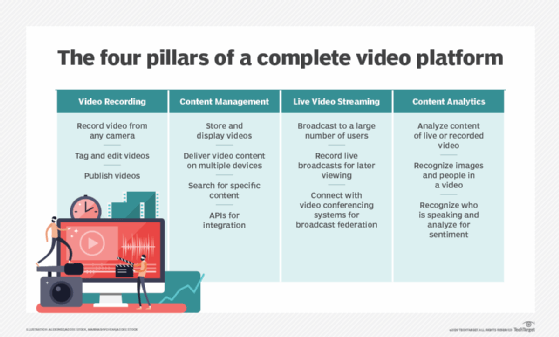
phasin - stock.adobe.com
The 4 pillars of a complete enterprise video platform
Video has become a key part of business workflows. Four foundational enterprise video platform capabilities can help organizations manage the growth of user-generated video.
Video is everywhere in the enterprise, thanks to the COVID-19 pandemic and ongoing remote work. Companies are taking a more strategic approach to their use of video to do more than just replace in-person meetings. Many are using video for a variety of internal and external communications use cases, including training, employee onboarding, town halls and events.
"For a post-COVID business world, video will continue to have a central role in our daily workflows," said David Maldow, founder of market research firm Let's Do Video, based in Davie, Fla.
For a successful video strategy, many organizations are turning to enterprise video platforms to manage video content created across the business.
What is an enterprise video platform?
Enterprise video platforms wrangle all forms of video in an organization to provide security, management and storage for businesses and integrate with popular video meeting platforms, including Cisco Webex, Microsoft Teams and Zoom. Many enterprise video platforms also offer integrations with third-party content delivery network, content management, marketing and sales platforms.
Enterprise video platform providers include Brightcove, Kaltura, Panopto and Qumu. Video recording, content management, live video streaming and content analytics are the main components of video platform architecture, according to an Aragon Research report on enterprise video.
IT decision-makers should consider these four pillars when exploring options for complete enterprise video platforms.
1. Video recording
The ability to create, edit and publish video content is a must-have for many organizations, according to the Aragon report. Recording is the first step to create video content. The growth of video across verticals has led to a need to support recording meetings, classroom lessons and trainings.
"With a new hybrid workforce, the power of recorded video isn't just that it can be accessed by remote workers; it's that it can be accessed at any time," Maldow said. "We can't expect the entire team to be at the office 9 to 5 every day to sit through our presentations; they need to be available on demand."
Video camera options are plentiful and range from built-in laptop cameras to standalone conferencing cameras. And, in today's mobile world, every cellphone has a camera, and organizations are encouraging employees to create their own video content, said Irwin Lazar, analyst at Metrigy, based in Mokena, Ill. As a result, enterprise video platforms must be compatible with any recording device.
Once recorded, users need to edit the video. In most cases, editing is as simple as trimming the beginning and end of a video to create a more professional and branded feel, Maldow said. While most enterprise video platforms provide basic editing tools, some organizations may need to explore offerings with a broader suite of editing capabilities.
Users also need to be able to tag and publish finished videos. Because tags are keywords that improve the accuracy of search results, users can identify information about a video, including people, places and subject matter. For example, if a user is searching for training videos, only videos tagged as training should show up in search results.
Video platforms should also enable users to publish videos. In many cases, admins can restrict access to a select few users who vet content before publishing it to the appropriate channel.

2. Content management
The second pillar of a complete video system is managing recorded content. The increased use of video has led to a sprawl of content that can be difficult to wrangle. But a video platform that includes video content management can make it easier for users to find video content, like recorded meetings, according to the Aragon report.
Before the pandemic, companies were hesitant to use video because of the perception that video files are large and dominate data storage or network usage. But real-world usage in the last two years has demonstrated that video can be used without significant network or storage problems, Maldow said.
"Today's video is transferred and stored far more efficiently," he said.
Once a video is recorded, edited and tagged, employees can use a video platform to retrieve and display a stored video file. The platform should be capable of delivering video to any device, regardless of the codecs needed to compress or decompress the file data, according to the Aragon report.
Content management in a video platform should include a searchable video library, where users can search video tags and titles for specific keywords to enable faster access to specific videos. Content management APIs can also enable users to integrate and embed video into business applications to make video information accessible without needing to open a separate application.
3. Live video streaming
The third pillar, live video streaming, has gained popularity in replacing large events, such as town halls and conferences. Prior to the pandemic, live video was used sparingly for large events. Now, organizations are embracing the dynamic nature of live visual broadcasts, Lazar said.
Enterprise video platforms should be able to handle broadcasting to large numbers of users in multiple locations. In addition to streaming, a complete video platform should support the ability to record live broadcasts, according to the Aragon report.
An enterprise video platform should be able to connect with whichever video conferencing system a company uses and federate the broadcast so it can be viewed in multiple conference rooms simultaneously.
Enterprise live streaming video, particularly virtual events, has had some growing pains due to streaming being so new to most businesses, but the experience will improve as users grow more accustomed to virtual events, Maldow said.
4. Content analytics
The fourth and final pillar of a complete enterprise video platform is analytics. Analytics enable the platform to detect people, places, images and audio in a video, which makes it easier to find relevant video information through improved tagging.
AI-enabled analytics can recognize visual information to locate specific snippets that match a search query. Rather than sifting through an hourlong video, AI can determine the relevant section of a video for a user based on the keywords used in the search query.
AI-driven analytics can provide better transcriptions and apply sentiment analysis to provide insight into what's happening in a video feed and how video content can drive business growth, according to the Aragon report.
Analytics will also be an important capability for industries that have increased their use of video during the pandemic, such as healthcare and insurance, according to the report.






